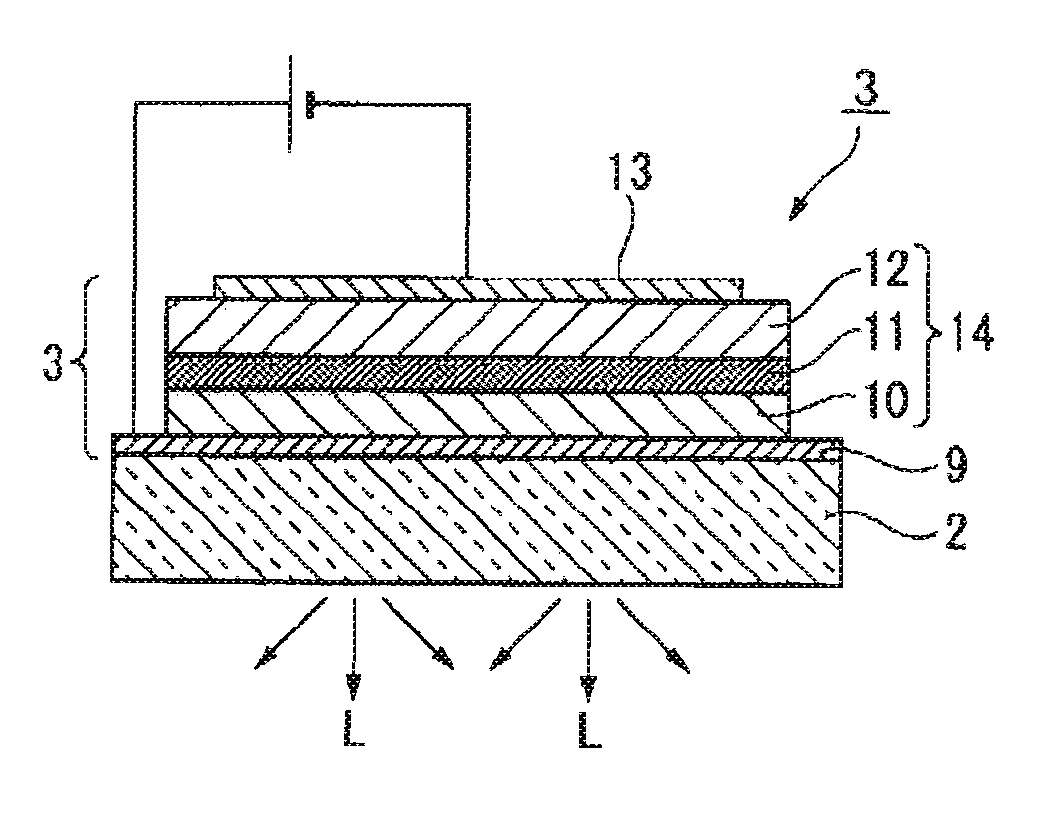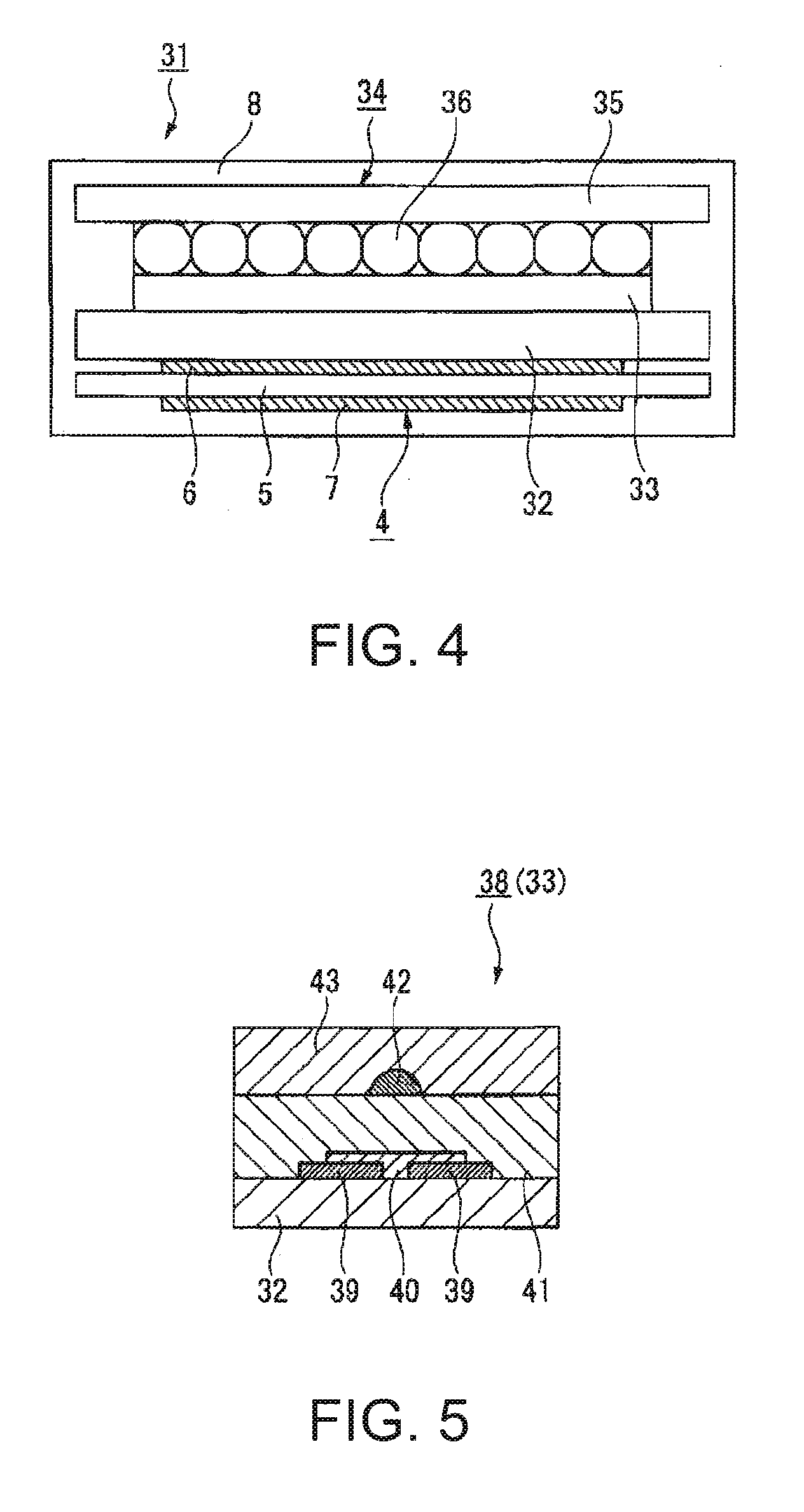Electronic device, organic electroluminescence device, and organic thin film semiconductor device
a semiconductor device and electroluminescent technology, applied in the direction of discharge tube luminescnet screen, discharge tube/lamp details, electrolysis components, etc., can solve the problems of insufficient sealing structure alone to improve reliability, and the effect of providing sealing structure is not long lasting, so as to achieve the effect of convenient manufacturing
- Summary
- Abstract
- Description
- Claims
- Application Information
AI Technical Summary
Benefits of technology
Problems solved by technology
Method used
Image
Examples
first embodiment
[0043] Hereinafter, a first embodiment of the invention will be explained with reference to FIGS. 1 and 2.
[0044] An organic electronic device of the present embodiment is an example of an organic EL device having an electrolytic element stacked on an organic EL element as a functional element.
[0045]FIG. 1 is a cross-sectional view of the organic EL device according to the present embodiment, and FIG. 2 is an enlarged cross-sectional view showing a detailed configuration of an organic EL substrate. It should be noted that in all of the following drawings, the scale ratios of respective sizes and film thicknesses are set differently for every configuration element so that each of the configuration elements can be viewed easily.
[0046] As shown in FIG. 1, the organic EL device 1 according to the present embodiment provided with an organic EL element 3 formed on one surface of a glass substrate 2, and an electrolytic element 4 stacked on the organic EL element 3. The electrolytic elem...
second embodiment
[0060] Hereinafter, a second embodiment of the invention will be described with reference to FIG. 3.
[0061] An organic electronic device of the present embodiment is an example of an organic EL device having an organic EL element as a functional element and an electrolytic element disposed in parallel to each other on a substrate.
[0062]FIG. 3 is a cross-sectional view of the organic EL device according to the present embodiment. Further, in FIG. 3, the elements common to those shown in FIG. 1 are provided with the same reference numerals, and detailed explanations therefor are omitted.
[0063] As shown in FIG. 3, the organic EL device 21 according to the present embodiment provided with an organic EL element 3 formed on one surface of a glass substrate 2, and an electrolytic element 4 formed adjacent to the organic EL element 3. The cathode 6 of the electrolytic element 4 is disposed on the side of the glass substrate 2, and the anode 7 thereof is disposed on the side opposite to th...
third embodiment
[0066] Hereinafter, a third embodiment of the invention will be described with reference to FIGS. 4 through 6.
[0067] An organic electronic device according to the present embodiment is an example of an electrophoretic display device having an organic TFT as a functional element and an electrophoretic element driven by the organic TFT both formed on one surface of the substrate and the electrolytic element formed on the other surface thereof respectively.
[0068]FIG. 4 is a cross-sectional view of the electrophoretic display device according to the present embodiment, FIG. 5 is a cross-sectional view only showing a part of the organic TFT, and FIG. 6 is a cross-sectional view of a modified example of the electrophoretic display device of the same. Further, in FIGS. 4 through 6, the elements common to those shown in FIG. 1 are provided with the same reference numerals, and detailed explanations therefor are omitted.
[0069] As shown in FIG. 4, the electrophoretic display device 31 of t...
PUM
| Property | Measurement | Unit |
|---|---|---|
| voltage | aaaaa | aaaaa |
| voltage | aaaaa | aaaaa |
| voltage | aaaaa | aaaaa |
Abstract
Description
Claims
Application Information
 Login to View More
Login to View More - R&D
- Intellectual Property
- Life Sciences
- Materials
- Tech Scout
- Unparalleled Data Quality
- Higher Quality Content
- 60% Fewer Hallucinations
Browse by: Latest US Patents, China's latest patents, Technical Efficacy Thesaurus, Application Domain, Technology Topic, Popular Technical Reports.
© 2025 PatSnap. All rights reserved.Legal|Privacy policy|Modern Slavery Act Transparency Statement|Sitemap|About US| Contact US: help@patsnap.com



